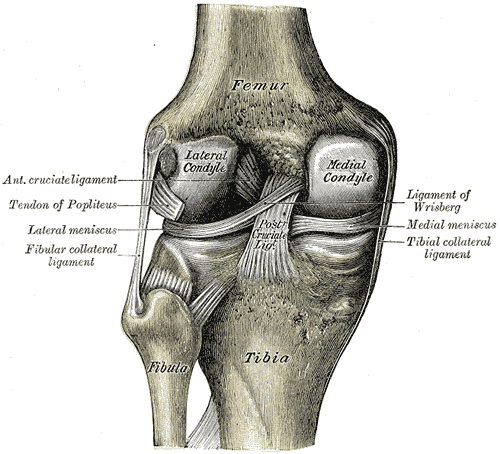YOUR PHYSIO
Condition directory
Knee cartilage pain following injury
Menisci are the cartilage disks that are found in our knees. There are two in each knee (one lateral and one medial) which act as shock absorbers and cushions to minimise the stress on the articular cartilage, which cover the ends of our bones.
There are two different ways which we can develop problems with our menisci. One is an acute injury where a sudden high load or force causes a tear across the meniscus, such as might happen with a sports injury. The other is known as a degenerative meniscus injury which is a more gradual onset. We are looking at an acute meniscal injury here but if you feel you have a degenerative meniscal injury please click here.

Acute meniscus injuries usually happen during sports. The injury is usually caused by a specific incident such as a twisting injury or following direct contact such as a rugby or football tackle. The severity of meniscus injuries varies.
The most common symptoms of meniscus tear are:
- Pain
- Reduced range of movement and stiffness
- The sensation of your knee "giving way"
- Painful catching or clicking sensations
- Swelling – usually immediately or within 2 hours of the injury
- Inability to fully straighten the knee
- Inability to weight bearSigns of a more serious injury are immediate severe swelling into the knee and difficulty walking or inability to fully straighten the knee. If you have these symptoms you should attend your local A&E department for further assessment and advice. If you feel you have a mild meniscal injury you can follow the advice on this page.
Treatment
Initial treatment after an acute injury involves the RICE principle. For more detailed information visit our acute soft tissue injury page here.
- Rest the affected area for at least the first 48 hours. You may require crutches to avoid putting weight on your leg.
- Ice can help to reduced swelling and inflammation. Only use for 20 minutes at a time but do not apply ice directly to the skin.
- Compression can help to prevent additional swelling. Wear an elastic compression bandage and remove for sleeping.
- Elevation can help to reduce swelling. Recline when you rest, and put your leg up higher than your heart.
Graded exercises may improve your symptoms. Often after an injury to the knee the thigh (quadriceps) muscles and bottom (glutes) becomes a little weaker and your movement can be reduced. The following exercises are can be useful to make them stronger and improve your movement:
If you are struggling to return to your normal activity levels or your knee is not settling, ask your GP for a referral to physiotherapy or fill out our self-referral form here.